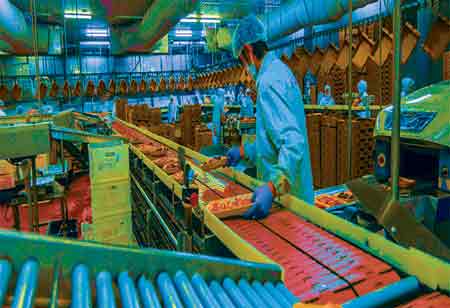Thank you for Subscribing to Food Business Review Weekly Brief
- Home
- Topics
- Alternative Proteins and Plant Based Food
- Beer and Wine
- Canned Beverages
- Coffee And Tea
- Food and Beverage Consulting
- Food and Beverage Financial Service
- Food And Beverages Marketing
- Food Distributors
- Food Ingredients
- Food Sustainability
- Plant Based Food and Beverages
- Seafood Suppliers
- Supplement Manufacturing
- Wine Investment
- News
- Vendor Viewpoint
- CXO Insights
- Conferences
- Newsletter
- CXO Awards
-
Advancements in Cold Storage Technology
Cold room containers transform food preservation through advancements that maintain optimal temperatures, humidity levels and safety.

By
Food Business Review | Wednesday, July 31, 2024
Stay ahead of the industry with exclusive feature stories on the top companies, expert insights and the latest news delivered straight to your inbox. Subscribe today.

Advancements in cold storage technology optimise efficiency and sustainability, reduce energy use, and maintain ideal conditions. Automated systems and temperature-responsive packaging further enhance food quality and lower costs.
FREMONT, CA: Cold room containers transform food preservation through advancements that maintain optimal temperatures, humidity levels and safety. The advanced storage solutions are designed for efficiency, reducing waste and enhancing food quality. As technology advances, cold room containers play a pivotal role in sustainable and effective food management, paving the way for innovations in food logistics and supply chain efficiency.
Here are a few technologies used in cold room storage:
Refrigeration Systems: These systems integrate IoT technology to monitor and control the temperature and humidity using sensors and analytics to optimise performance, detect anomalies, and perform predictive maintenance. This technology enhances energy efficiency and reduces operational costs by minimising energy waste and preventing equipment failures. Advanced features include remote access, automated alerts, and integration with building management systems. These systems are crucial for maintaining optimal conditions in cold storage facilities.
Cryogenic Storage Solutions: Involves using extremely low temperatures, typically below -150°C (-238°F), to preserve biological samples, pharmaceuticals, and other sensitive materials. This technology relies on liquid nitrogen or other cryogens to maintain these ultra-cold conditions. Cryogenic storage is essential for the long-term preservation of cells, tissues, and vaccines, ensuring their viability and efficacy through innovations in cryogenic storage, including improved containment systems and more efficient cooling methods. These advancements help minimise energy consumption, enhance storage reliability and support research medical applications by providing stable and safe storage conditions.
Phase Change Materials (PCMs): Absorb or release latent heat during the transition from solid to liquid in cold storage. PCMs help maintain stable temperatures by absorbing excess heat or releasing stored coolness. This technology is used in packaging and storage systems to extend temperature stability during transport and storage. The advanced PCMs are activated at specific temperature ranges, improving control. They reduce the need for continuous refrigeration and lower energy consumption, contributing to reducing spoilage and ensuring product quality.
Energy-Efficient Cold Storage Design: Focuses on facility construction and operation to minimise energy use of high-performance insulation, energy-efficient refrigeration systems, and advanced building materials. Strategies involve designing for natural ventilation, implementing energy recovery systems, and using LED lighting. Modern designs also incorporate renewable energy sources, like solar panels, to power refrigeration systems. These designs aim to reduce operational costs and environmental impact by improving energy efficiency. Facilities can achieve lower greenhouse gas emissions and comply with sustainability standards.
Automated Cold Storage Systems: The storage systems use robotics and advanced technologies to manage inventory and streamline operations with automated systems, including robotic, transportation, and sorting systems that handle good precision and speed. These systems enhance efficiency by reducing manual labour, minimising errors, and optimising space utilisation. They also enable tracking and inventory management through integrated software. Automation and accuracy in cold storage facilities improve throughout. These systems contribute to better resource management and reduced operational costs.
Temperature-Responsive Packaging: Temperature-responsive packaging utilises materials and technologies that actively regulate the internal temperature of packaged goods. Innovations include coatings and materials that adjust to temperature fluctuations to maintain optimal conditions. This type of packaging features insulation layers, phase change materials, and active cooling elements for packing, preserving the quality and safety of temperature-sensitive products during transport and storage. It helps prevent spoilage and extend shelf life and also aids in compliance with temperature-sensitive regulations.
Sustainable Cold Storage Practices: Focus on minimising the environmental impact of cold storage operations, including adopting energy-efficient technologies, using natural refrigerants, and implementing waste reduction strategies. Sustainable practices involve designing facilities to maximise energy conservation and integrating renewable energy sources, including recycling and reusing refrigerants and improving insulation to reduce energy consumption. These practices contribute to lowering greenhouse gas emissions, reducing the carbon footprint of cold storage operations, and supporting broader sustainability goals to enhance environmental stewardship.
The advancements in cold room container technology are developing food preservation by embracing these innovative technologies and sustainable practices. The industry improves operational efficiency, reduces costs, and contributes to a greener future, aligning with global efforts to combat climate change and promote sustainable food management.






